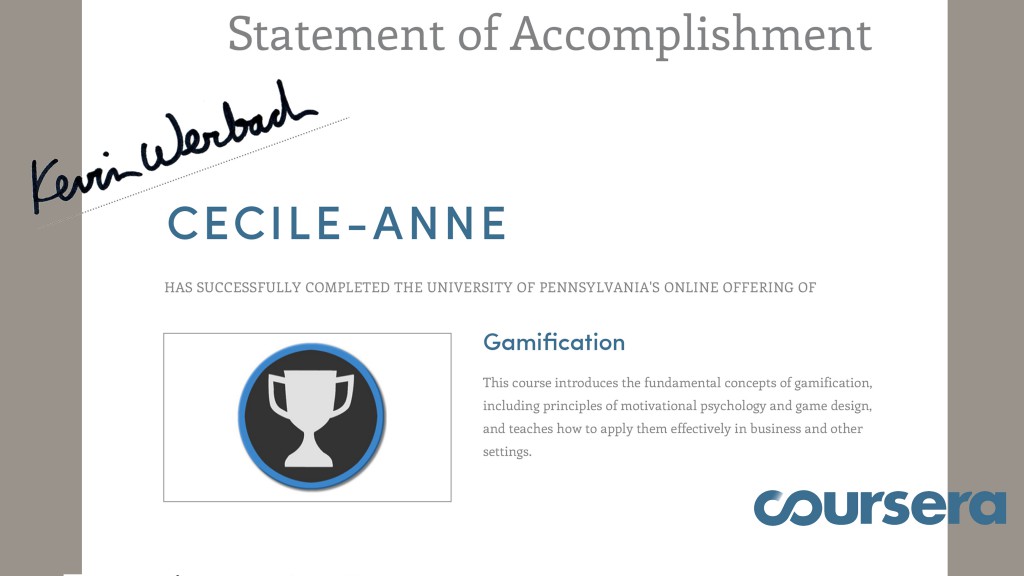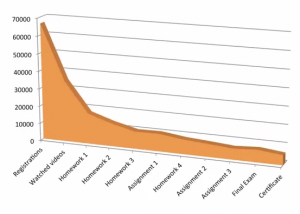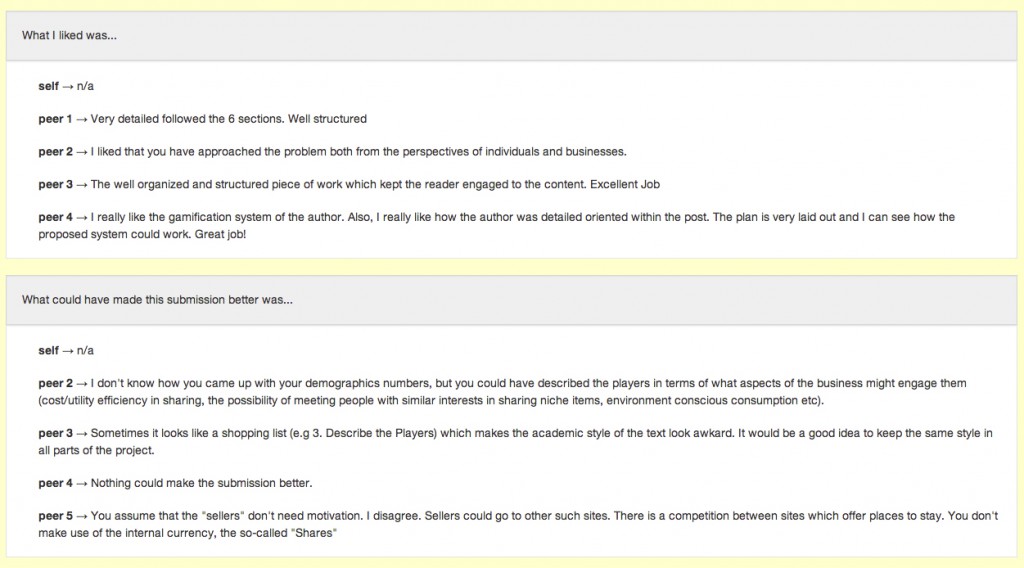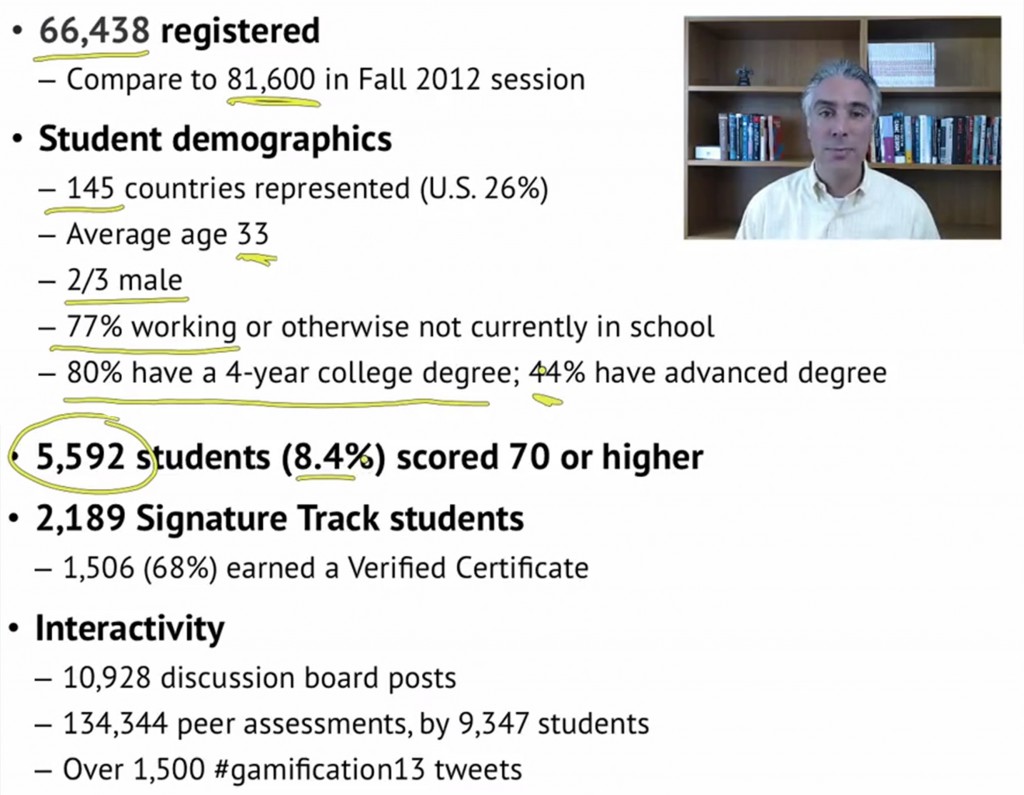MOOCs are a big topic at Northwestern right now, with the University exploring both Coursera and 2U classes for next year. So what’s it all about? What will it mean for students to take a MOOC? I recently completed my first Coursera course and I have to admit it was tough, but not in the way you might think.
Maybe this is a little bit meta, since the Coursera course I took was the second iteration of Gamification taught by Kevin Werbach at UPenn’s Wharton School of Business. There was a lot of psychology in broad terms focusing on motivation in relation to target audiences so I can’t help but make parallels between the talking points of the lectures to how I approached the class. Werbach himself even copped to utilizing certain aspects of Gamification based on what he knows about motivation in the structure of the class. And truly, that’s what I had the most trouble with – pushing myself to continue.
Coursera is a different beast than 2U. Ideally, 2U classes will allow you to get credit at your institution (exactly how much credit equivalency remains to be seen). If you’re enrolled in a participating institution, you can enroll in a 2U class. Coursera is free and anyone – and I mean ANYONE – so long as you have a computer and an internet connection, can take it. I guess that’s why the M in MOOC stands for Massive(-ly). To give you an idea of how massive, midway through the course we received an email with the stats. Originally around 63,000 people had registered for the course and only 12,000 handed in the first assignment. They expected this sort of attrition, but what’s amazing is that Gamification is a popular course and this percentage of loss was actually much less than most.
So what was so hard for me? Why do so many people drop out? What’s the difference between going to class online and physically going to class? Sure, it’s been at least 7 years since I last took a college level class. I will freely admit that while attending Northwestern, my alma mater, I occasionally missed class on purpose (my reasoning being that sometimes I prioritized learning through my extra-curriculars over lectures). The difference was, I knew if I missed a physical class, I had friends to catch me up. I wasn’t a total slacker back in the day, and when it came down to the graded elements, I always knew I would figure it out and manage to pass whatever tests or essays came my way. I was always accountable, and I had a professor who would call me out if I stepped out of line. I think there was also the aspect of “the class is paid for already and it is a service for me” – like I was paying for the final grade on my transcript rather than the actual things I learned. With Coursera, I didn’t pay for it, so the only person keeping me accountable was myself.
So with a MOOC like this, there has to be an honest interest in the subject matter or there has to be a reason to know the material – you have to want to learn the material. Otherwise, there isn’t anything that will force you to watch the video lectures. You have to actually set aside time to watch the videos, do the homework (in some cases but not this particular course, even read). No peer pressure, it’s all on you. Granted, Coursera offers a “Signature-Track” where you can pay around $40.00 to have all of your work linked to your name (rather than a number) –
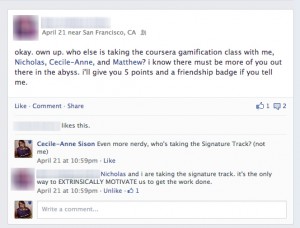
While paying my tuition during my undergraduate years might have been a de-motivator for me to attend class, for my friend paying was motivation for her to attend her Coursera class.
while I was lamenting my lack of motivation on Facebook, I found out a friend was also taking the class (the massiveness of the class making the world even smaller) and she confessed that paying the money was the only way she would be motivated to do the work. So here monetized motivation works in the opposite way than normal tuition did for me – when no credit is at stake, not completing the work would seem like a waste of the $40.00!
I had an interest in the topic, so that was enough to push me to “attend” the weekly two hours or so of lectures (it helped that I could do things like wash dishes while doing this). After taking this course, I’ve since learned (through my perusal of other course options and by comments made by friends and colleagues) that the production value of the the Gamification course is not the norm. I can’t even imagine what I would do if Professor Werbach’s delivery had been less engaging or if the lighting was terrible or if he hadn’t done as much prep work as he did. I won’t sit through a movie that bores me to tears, so I definitely wouldn’t sit through lectures. So I have to give Professor Werbach props for all of his work dividing up his lectures into easy digestable bites and trying to make the visuals high quality and as interactive as possible. He even had a game going on in the background of his lectures for the observant many (I won’t spoil it for you in case you want to take this class yourself). He peppered his lectures with the occasional guest interview, and while the subject matter was useful for real world examples, sometimes the lack of finesse with the recording made it difficult for me to want to watch. You might say, “but Cecile, you make media – you’re just being picky!” but I swear to you it makes a difference. People may be forgiving of shaky-cam, but the minute the audio is not up to scratch, people turn off what they’re watching. I don’t have the facts and figures, but I know that Gamification retains a higher percentage of enrolled students than most other courses. I’d be willing to bet much of it has to do with the fact that his videos don’t suck.
So I’d committed to at least watching the videos, but we also had assignments – how did I choose to actively participate rather than just audit the class? We had quizzes (which were obviously open note, with both multiple choice and multiple selection type questions). I wonder about my retention of the topics for these quizzes because for me the information was so current – I would watch the video and immediately take the quiz. While learning all of these things superficially, it’s really up to me how well everything sinks into my head. For the most part I did well on these. We also had written assignments of business proposals and GRADING of our peers’ written assignments (which I will go into a little more in depth on). Since we were given a rubric to use for grading at the time that we were writing our own, I felt that the writing assignments acted more like busy work than deep theorizing. I was regurgitating notes from the video lectures for the most part and just organizing it a way that would satisfy the rubric. This rubric was both a ticket to passing the course, yet also a crutch that made it hard for me to invest myself in the writing. Though the process of writing helped me solidify concepts but given the constraints (and even word count), it was hard to feel like any of the writing was meaningful. Especially since I knew that my work wasn’t going to be read by the authority on the subject (Professor Werbach) but just my peers (which I’m getting to). At least I didn’t feel regret about passing on the Signature Track, since I can’t imagine anyone wanting to read my work!
With all that said, I did very well on the written assignments. Perfect scores across the board. I don’t say this to brag, I say it to show that if you follow the rubric, you can’t fail. So this brings me to the point where I talk about the hardest part of the class for me – Grading my peers. This is the thing about MOOCs – since anyone can take a Coursera course, you have different levels of students and different levels of understanding, and even people who have varying grasps of how to write a Business Proposal. You even have different ages of people from teenagers all the way to people in their 80s. The majority of these people are not currently enrolled in school. It was difficult for me to grade my “peers” (quotations intentional), so much so that grading the first assignment was the point where I considered dropping. And I was not alone. In Professor Werbach’s wrap up video of the class, he says that the “precipitous drop in enrollment” happens when the peer assessments roll around. For me, it wasn’t because some of the assignments were hard to figure out what the point was (one infamous assignment I had to grade included an emoticon). It’s because this was actually the most work for me, it’s where I actually applied my mind the most – reading and understanding. And I wasn’t sure until that moment what this class could offer me that I couldn’t learn simply by reading Professor Werbach’s book. I will say (and Matt I’m sure will echo my thoughts) that some of my reviewers, when answering “What they liked” or “What they thought I could improve on”, really surprised me with their insight. I guess the type of people who continue in the course past this point are the type of people that care. So I guess I was *one of them.
So the question remains. Will I take another Coursera course? The answer to that is a resounding yes! I’m “watching” for some classes that will be offered again that seemed interesting so hopefully they’ll happen when I have enough spare time to devote to it. Learning for learning sake should be enough motivation for me now. Do you have an idea for a course you want to build into a MOOC? When you do, keep in mind your audience’s experiences – it’s one thing to make a MOOC, it’s quite another to have your students stay with you to the end. With all that said, I leave you with some statistics on the class that Professor Werbach compiled because when you teach that MOOC, there’s no telling who your student might be.
* To a point – I didn’t care enough to participate in the message boards.
